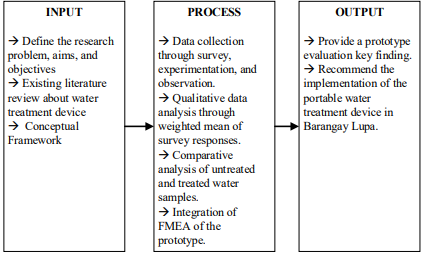Innovating Community-Based Drinking Water Treatment: A Mobile Device in Barangay Lupa, Compostela, Cebu

Submission to VIJ 2024-05-31
Keywords
- water treatment,
- mobile,
- filtration,
- disinfection,
- drinking water
Copyright (c) 2024 Jamaica S. Plarisan, Kyle G. Conde, Giles B. Almaden, Rosegen A. Sarsalejos, Clorie Mae H. Arsolon, Angelique Y. Cabiging, Gilliana Eve Y. Arioja, Kyla Shenna M. Acaso, Dreian A. Narte, Renz Q. Ulgasan, Jestoni P. Tan, MSEE, Donald R. Lalican, MEIE, PIE

This work is licensed under a Creative Commons Attribution 4.0 International License.
Abstract
In response to the significant issue of insufficient access to safe drinking water in the mountainous barangay of Lupa, Compostela, Cebu, this study provides a customized mobile water treatment device that seeks to address current drinking water issues, providing mitigation to the community. The treated water undergoes rigorous laboratory testing to determine the device's treatment performance on deep-well water sources in the barangay. This study evaluated the device's acceptability level, performance, and potential weaknesses using weighted mean calculations, microbial contamination calculations, and Failure Mode and Effects Analysis (FMEA). The results reveal a significant level of acceptance among respondents toward adopting the mobile water treatment device. Moreover, the device’s treated water effectively meets the 2017 Philippine National Drinking Water Standards, making it safe for drinking. However, observation highlights device vulnerabilities, particularly the water pump's tendency to overheat and the UV sterilizer's sensitivity, emphasizing the importance of consistent monitoring and maintenance practices.
References
- Mishra, B. K., Kumar, P., Saraswat, C., Chakraborty, S., & Gautam, A. (2021). Water security in a changing environment: concept, challenges and solutions. Water, 13(4), 490. https://doi.org/10.3390/w13040490.
- UNESCO (2021). The United Nations World Water Development Report 2021. Valuing Water. United Nations Educational, Scientific and Cultural Organization. https://unesdoc.unesco.org/ark:/48223/pf0000375724.
- World Health Organization: WHO. (2019). 1 in 3 people globally do not have access to safe drinking water – UNICEF, WHO. World Health Organization. https://www.who.int/news/item/18-06-2019-1-in-3-people-globally-do-not-have-access-to-safe-drinking-water-unicef-who.
- Field Health Services Information System Annual (2021). FIELD HEALTH SERVICES INFORMATION SYSTEM ANNUAL 2021 Technical Report. https://caro.doh.gov.ph/wp-content/uploads/2022/09/FHSIS-2021-Annual-Report-v2.pdf
- PhilAtlas (2023). Lupa Municipality of Compostela Province of Cebu. https://www.philatlas.com/visayas/r07/cebu/compostela/lupa.html.
- Dam, R. F., & Siang, T. Y. (2024). Empathy Map – why and how to use it. The Interaction Design Foundation. https://www.interaction-design.org/literature/article/empathy-map-why-and-how-to-use-it
- Schuerman, B. (2021). Total Coliform Bacteria in Drinking Water. UNL Water. Institute of Agriculture and Natural Resources. University of Nebraska-Lincoln. https://water.unl.edu/article/drinking-water-wells/total-coliform-bacteria-drinking-water
- Hammad, A., Eltahan, A., Hassan, H., Abbas, N., Hussien, H., and Shimamoto, T. (2022). Loads of Coliforms and Fecal Coliforms and Characterization of Thermotolerant Escherichia coli in Fresh Raw Milk Cheese. Foods. MDPI. https://www.ncbi.nlm.nih.gov/pmc/articles/PMC8834472/
- Sitaram, D. U. (2022). Study of the physio-chemical parameters for testing water: A review. World Journal of Advanced Research and Reviews, 2022, 14(03), 570–575. https://doi.org/10.30574/wjarr.2022.14.3.0600
- Reena, M., Amalraj, A., Ajitha, R., & Louis, C. N. (2022). A study of physico-chemical parameters of well and bore hole water in Pozhikkarai to Manavalakkurichi South Coast of Tamil Nādu. International Journal of Science and Research Archive, 7(2), 221–233. https://doi.org/10.30574/ijsra.2022.7.2.0277
- SL Power Electronics (2019). New application note – Design considerations for maximum allowable temperature. SL Power Electronics. https://slpower.com/archives/10261
